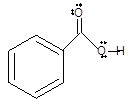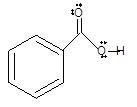
(a)
Interpretation: The 50 % ionization of benzoic acid at pH 4.2 needs to be determined if the pKa of benzoic acid is 4.2.

Concept Introduction: Bronsted and Lowry purposed the Bronsted-Lowry acid-base theory. It states that acid can give
(b)
Interpretation: The reason of precipitation of benzoic acid needs to be explained if the pH of an aqueous solution of benzoate ion is lowered to pH 7 by adding acid.

Concept Introduction:Bronsted and Lowry purposed the Bronsted-Lowry acid-base theory. It states that acid can give
Want to see the full answer?
Check out a sample textbook solution
Chapter 5 Solutions
EBK EXPERIMENTAL ORGANIC CHEMISTRY: A M
- A.) The value of Ka for hydrocyanic acid is 4.00×10-10.What is the value of Kb, for its conjugate base, CN-? B.) In the laboratory, a general chemistry student measured the pH of a 0.589 M aqueous solution of benzoic acid, C6H5COOH to be 2.199.Use the information she obtained to determine the Ka for this acid.Ka(experiment) =arrow_forward5. Show that the product of the dissociation constant (Ka) of a weak acid and the hydrolysis constant (Kb) of its conjugate base is the ion product of water (Kw). 6. Some biological acids are phosphoric acid derivatives and some are carboxylic acid derivative. i. Using phosphoric acid H3PO4, write and expression for а. ст b.a, in terms of K, ii. Consider the speciation curve for H2CO; below and use it to estimate the Ka (acid dissociation constant) for the reaction: H2CO3 + HCO; +H* 09 08 0.7 06 0.5 04 0.3 02 0.1 10 12 14 Guy Sawle, http://www.ozekoi.com/relationship%20between%20pH.pdfarrow_forwarda. A 1.00 liter solution contains 0.45 moles nitrous acid and 0.35 moles potassium nitrite .If 0.17 moles of hydroiodic acid are added to this system, indicate whether the following statements are true or false.(Assume that the volume does not change upon the addition of hydroiodic acid.) A. The number of moles of HNO2 will decrease. B. The number of moles of NO2- will decrease. C. The equilibrium concentration of H3O+ will remain the same. D. The pH will increase. E. The ratio of [HNO2] / [NO2-] will increase. b. A 1.00 liter solution contains 0.38 M ammonia and 0.49 M ammonium bromide. If 0.120 moles of barium hydroxide are added to this system, indicate whether the following statements are true or false. (Assume that the volume does not change upon the addition of barium hydroxide.) A. The number of moles of NH3 will decrease. B. The number of moles of NH4+ will decrease. C. The equilibrium concentration of H3O+ will increase. D. The pH will increase. E. The ratio of [NH3] /…arrow_forward
- Calcium phosphate (Ca3(PO4)2; MM = 310.18 g/mol), a large component of human bones and teeth, has a Ksp of 2.07 × 10-33 at 25 °C. A. Write the reaction equation for the dissolution of Ca3(PO4)2 solid (in your solution sheet). B. Calculate the solubility in mg/L at 25 °C in pure water. Neglect other competing equilibria. I C. Calculate the solubility in mg/L at 25 °C in the presence of 0.010 M CaCl₂. Neglect other competing equilibria. Assume that 3s << 0.010 M. D. Is the assumption that s << 0.010 M valid? (Yes or No)arrow_forward3. Caffeine is an alkaloid and has base characteristics. Of the four nitrogens in the structure of the molecule, which one(s) would give it this property? sneltro benti 4. Besides caffeine, what else is extracted into the tea? Why can you use the basic salt, Na₂CO3, sodium carbonate, to remove this material? 5. What criterion is used for the purity of a sample of caffeine?arrow_forwardSOLUBILITY PRODUCT PRINCIPLE Calcium phosphate (Ca3(PO4)2; MM = 310.18 g/mol), a large component of human bones and teeth, has a Ksp of 2.07 x 10-33 at 25 °C. A. Write the reaction equation for the dissolution of Ca3(PO4)2 solid (in your solution sheet). B. Calculate the solubility in mg/L at 25 °C in pure water. Neglect other competing equilibria. C. Calculate the solubility in mg/L at 25 °C in the presence of 0.010 M CaCl₂. Neglect other competing equilibria. Assume that 3s << 0.010 M. D. Is the assumption that s << 0.010 M valid? (Yes or No)arrow_forward
- Calculate the pH at 25 °C of a 0.46 M solution of potassium butanoate (KC,H,CO,). Note that butanoic acid (HC,H,CO,) is a weak acid with a pK, of 4.82. Round your answer to 1 decimal place.arrow_forwardIn this experiment, your goal is to determine the amount of lead present in a water sample and, if lead is present, to determine whether the level of contamination is potentially dangerous. Preliminary preparation of the sample has resulted in a solid of unknown composition. This solid contains lead (Pb 2+ ) in the form of a water soluble salt and gravimetric analysis will be used to determine the amount of lead present. Step 1. Preparation of precipitating agents : Dissolve a predetermine amount of sodium sulfate in distilled water to produce 100mL with a concentration of 0.175M. Transfer the solution in the burette.Step 2. Obtain 3 10-mL sample of wastewater which contains lead in an erlenmeyer flask.Step 3. Dilute the 10 ml sample with water to 100mL.Step 4. Add an excess amount of sodium sulfate to achieved complete precipitation.Step 5. Filter the solution using a pre-weighed filter paper.Step 6. Collect the precipitates in filter paper and dry in an oven at 105 o C for 3 hrs or…arrow_forward6. HOCI is an acid in aqueous solution with Ka = 3.49 x 10-8 at 25.0 °C a. Write the chemical equation for the ionization equilibrium of HOCI in water. Include physical states and appropriate charges. b. 0.35 mol of HOCI is added to 1L of water at 25.0 °C, calculate the pH of the resulting solution. c. Write the chemical equation for the ionization equilibrium of CIO™ in water. Include physical states.arrow_forward
- Determine the quantity of sodium acetate (CHCOONa) needed to create buffer solution at a particular pH. Do this by constructing an ICE table, writing the equilibrium constant expression, and using this information to determine the mass of starting material required. The value of Ka for CH,COOH is 1.8 x 10°. Complete Parts 1-3 before submitting your answer. NEXT > Sodium acetate (CHCOONa) is added to an existing 500.0 mL solution of 0.200 M CH₂COOH to form a buffer with a pH equal to 5.000. Let x represent the concentration of CH,COO in the water after the addition of CH,COONa. Fill in the ICE table with the appropriate value for each involved species to determine concentrations of all reactants and products. CH,COOH(aq) Initial (M) Change (M) Equilibrium (M) + x 0.200 Н.О(1) 1.0 × 10 -1.0 × 10° 1.8 x 10° x x+1.0×10-x-1.0 10-18 10-x-18 10-1 -1.8 x 10 5.00 x + 5.00 -5.00 HO(aq) 1.0*10* + CH,COO (aq) RESET -1.0 x 10° x-5.00 x+ 10×10-x-1.0×10-* Determine the quantity of sodium acetate…arrow_forwardDetermine the pH of a solution by constructing a BCA table, constructing an ICE table, writing the equilibrium constant expression, and using this information to determine the pH. Complete Parts 1-4 before submitting your answer. 1 3 4 NEXT > Two solutions are mixed: 40.0 mL of 0.500 M NH3 and 25.0 mL of 0.300 M HCI. Fill in the table with the appropriate value for each involved species to determine the moles of reactant and product after the reaction of the acid and base. Before (mol) Change (mol) After (mol) -0.0075 Initial (M) Change (M) Equilibrium (M) E 0.313 - x 0 0.0100 0 0.500 + x 40.0 0.115 + x NH3(aq) -0.0100 NH3(aq) + 0.500 2 0.500 - x 0.115-x 0.500 2 0.0125 : on by constructing a BCA table, constructing an ICE table, ant expression, and using this information to determine the pH. Complete Parts 1-4 before submitting your answer. -■· 0.300 +arrow_forwardCalculate the pH at 25 °C of a 0.72M solution of potassium butanoate (KC,H,Co,). Note that butanoic acid (HC, H,CO,) is a weak acid with a p K, of 4.82. Round your answer to 1 decimal place. PH = 回山因arrow_forward
 Chemistry & Chemical ReactivityChemistryISBN:9781337399074Author:John C. Kotz, Paul M. Treichel, John Townsend, David TreichelPublisher:Cengage Learning
Chemistry & Chemical ReactivityChemistryISBN:9781337399074Author:John C. Kotz, Paul M. Treichel, John Townsend, David TreichelPublisher:Cengage Learning
